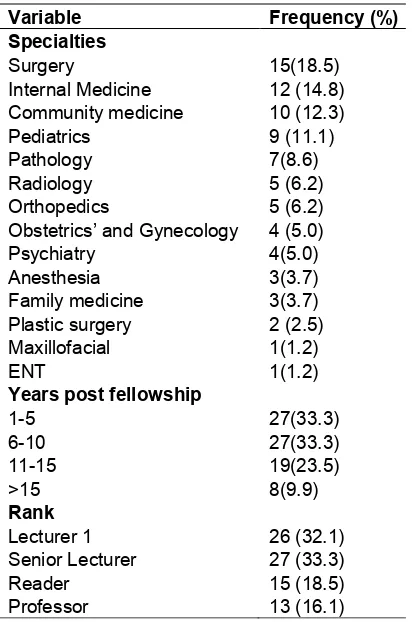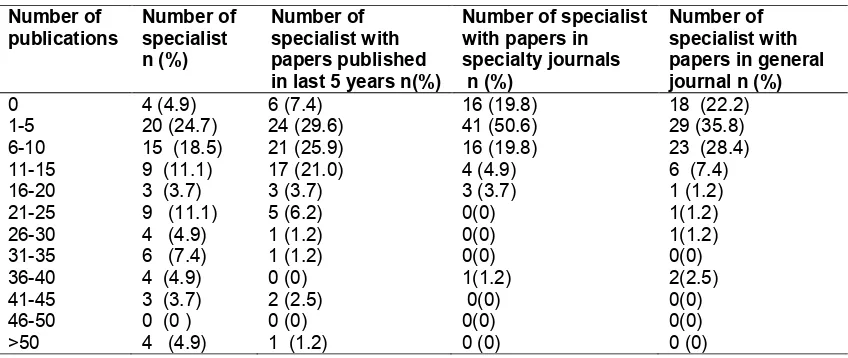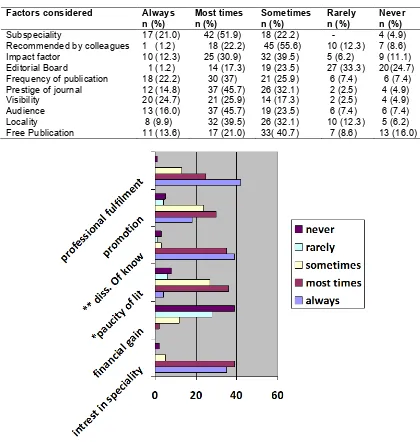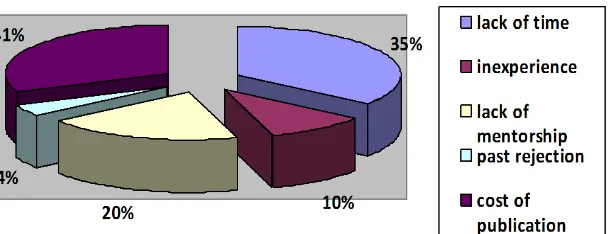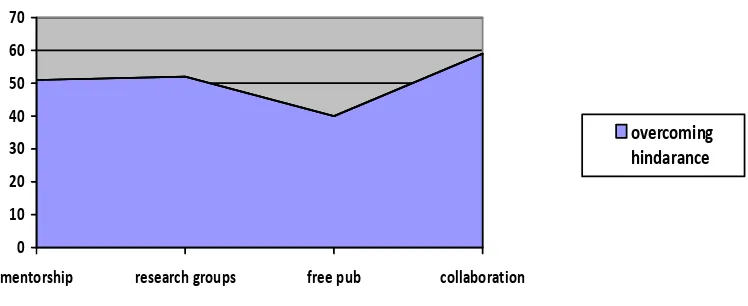_____________________________________________________________________________________________________
*Corresponding author: E-mail: bakhiwu@yahoo.com;
(Past name: British Journal of Medicine and Medical Research, Past ISSN: 2231-0614, NLM ID: 101570965)
Determinants, Hindrances, and Motivators to
Choose Journals in Which to Publish AMONG
Researchers in a Tertiary Care Hospital
A. S. Adoga
1, B. I. Akhiwu
2*, H. O. Akhiwu
3, E. I. Agaba
4,
M. P. Chingle
5, T. Afolaranmi
5and J. Musa
61
Department of Ear Nose and Throat Surgery, Jos University Teaching Hospital/University of Jos, Plateau State, Nigeria.
2Department of Dental and Maxillofacial Surgery, Jos University Teaching Hospital/ University of Jos,
Plateau State, Nigeria.
3Department of Paediatrics, Jos University Teaching Hospital, Plateau State, Nigeria. 4
Department of Medicine, Jos University Teaching Hospital/University of Jos, Plateau State, Nigeria.
5
Department of Community Medicine, Jos University Teaching Hospital/University of Jos, Plateau State, Nigeria.
6Department of Obstetrics and Gynecology, Jos University Teaching Hospital/University of Jos,
Plateau State, Nigeria.
Authors’ contributions
This work was carried out in collaboration between all authors. Author ASA designed the study, performed the statistical analysis, wrote the protocol, and wrote the first draft of the manuscript. Authors BIA and HOA managed the analyses of the study. Authors BIA, HOA, EIA, MPC, TA and JM
managed the literature searches. All authors read and approved the final manuscript.
Article Information
DOI: 10.9734/JAMMR/2018/41618 Editor(s): (1) Dr. James Anthony Giglio, Adjunct Clinical Professor, Oral and Maxillofacial Surgery, School of Dentistry, Virginia Commonwealth University, Virginia, USA. Reviewers: (1) Lolita Rapoliene, Klaipeda University, Lithuania. (2)Paulo Roberto Barbosa Evora, University of São Paulo, Brazil. Complete Peer review History:http://www.sciencedomain.org/review-history/25541
Received 26th February 2018 Accepted 5th May 2018 Published 13th July 2018
ABSTRACT
Background: Publication of articles in peer-reviewed journals is a major way to disseminate current information on various medical topics. We sought to identify the factors that act as determinants of the choice of a journal by researchers in a tertiary center as well as the hindrances and motivators to publish.
Materials and Methods: This was a cross sectional study performed at the Jos University Teaching Hospital a federal academic medical referral center that has specialist in the specialties of medicine, surgery, pediatrics, obstetrics, gynecology and dentistry. We distributed a structured self-administered questionnaire to 81 members of the medical staff who were researchers working with the University of Jos and at the 2017 annual general meeting of The Medical and Dental Consultants Association of Nigeria (MDCAN) and consented to participate in the study. SPSS statistical software version 18 was used for data analysis.
Results: We identified that the visibility of a journal, specialty covered, frequency of publication, recommendation by a colleague, and no costs to publish are the major factors that determine choice of journal for publication. Dissemination of knowledge was found to be the major motivator to publish. However lack of time and cost of publication are major hindrances to publication. Respondents said that a suitable academic environment, research mentorship, and promotion are major factors that would enhance and encourage publications.
Conclusion: We identified that the visibility of a journal, specialty covered by the journal and frequency of publications are the major factors that determine choice of journal for publication. If the major hindrances to publication can be adequately addressed and the motivations to publications promoted, more articles would be published from this region where research and publications are currently under-represented.
Keywords: Choice of journals; determinants; hindrances; motivators; research personnel; questionnaires.
1. INTRODUCTION
Dissemination of research findings is one of the major avenues for sharing knowledge, improving practice, and gaining visibility in chosen areas of career or research practice [1-3]. This is mostly achieved through peer-reviewed journal article publications. The publication of a manuscript serves to effectively validate the authors work, help career advancement, attract brilliant students and experienced staff, as well as attract funding for future studies [4]. In view of the growing article publication drive in Africa with most of Africa still lacking in research and very little information published on the determinants of the choice of peer-reviewed journals to be used; this study was conceived and carried out to determine the factors influencing the choice of journal for article publication among researchers in a tertiary health institution, identify causes of article rejection, and suggest ways to overcome obstacles and increase publications.
2. METHODOLOGY
2.1 Study Setting
The study was carried out in Jos, Plateau State, North Central Nigeria. Plateau State has 2 tertiary health care centers: Bingham University Teaching Hospital and the Jos University Teaching Hospital (JUTH). Of the 2 centers, Jos University Teaching Hospital (JUTH) is the larger center and affiliated with the University of Jos
(the only federal government owned university in the State).
The 620 bed Jos University Teaching Hospital has specialists of medicine, surgery, pediatrics, obstetrics and gynecology, and dentistry. The hospital receives referrals from the neighboring states of Benue, Nassarawa, Kogi and Bauchi. There are currently 148 specialty consultants working with the Jos University Teaching Hospital and who are also lecturers at the University of Jos.
2.2 Study Population
Specialist consultants working with JUTH who were also Lecturers with the University of Jos. The inclusion criterion was all consultants in medical specialty or sub- specialty employed by the University of Jos, working with the Jos University Teaching Hospital who consented to participate in the study while specialist consultants out of state or the country were excluded.
2.3 Study Design
for publishing, number of papers published, past manuscript rejection and cause, factors that enhance publication, factors hindering publication and how to overcome factors hindering publication.
2.4 Sample Size Determination
There are currently 148 specialist consultants working with the Jos university teaching hospital who are also lecturers with the University of Jos. Attempt was made to recruit all the specialist doctors. However, at the end of the study we were able to retrieve 81 questionnaires that were eligible for analysis.
2.5 Ethical Clearance
This was obtained from the health research review board of Jos University Teaching Hospital while informed consent was obtained from the subjects.
2.6 Methods
The questionnaires were pre-tested and validated in a pilot study. Each consultant that consented to participate in the study was given a questionnaire and instructed to fill and return within 48 hours. They were informed on designated areas where the questionnaires were to be submitted. Questionnaires that were not properly filled were excluded from the study at the end of the study 81 properly filled questionnaires were retrieved.
2.7 Data Analysis
The information from the questionnaires was entered into SSPS version 18 (Chicago IL) for analysis. The characteristics of the study population were presented in tables as frequencies and percentages; while the categorical variables were presented as bar charts and pie charts.
3. RESULTS
A total of 81 medical consultants (86.4% males and 13.6% females) from various sub-specialties were studied. The characteristics of the study population and the number of manuscripts published are represented in Tables 1-3. The factors considered by the authors before deciding to publish in a journal are presented in Table 4 Factors that motivate the authors to
publish in a particular journal, reasons for article rejection, factors that enhance publication, factors that hinder publication as well as overcoming hindrance to publication are documented in Figs. 1-5.
Fifteen of the respondents were surgeons while only one was in ENT surgery. Majority (66.6%) were less than 10 years post fellowship. See Table 2.
Table 1. Characteristics of the study population
Variable Frequency (%) Mean ± SD
Age group 44 ± 4.2
36- 40 16 (19.7) 41- 45 38 (46.9) 46- 50 19 (23.5) 51- 55 8 (9.9) Gender
Males 70 (86.4) Females 11 (13.6)
Table 2. Employment characteristics of the respondents
Variable Frequency (%)
Specialties
Surgery 15(18.5)
Internal Medicine 12 (14.8)
Community medicine 10 (12.3)
Pediatrics 9 (11.1)
Pathology 7(8.6)
Radiology 5 (6.2)
Orthopedics 5 (6.2)
Obstetrics’ and Gynecology 4 (5.0)
Psychiatry 4(5.0)
Anesthesia 3(3.7)
Family medicine 3(3.7)
Plastic surgery 2 (2.5)
Maxillofacial 1(1.2)
ENT 1(1.2)
Years post fellowship
1-5 27(33.3)
6-10 27(33.3)
11-15 19(23.5)
>15 8(9.9)
Rank
Lecturer 1 26 (32.1)
Senior Lecturer 27 (33.3)
Reader 15 (18.5)
When the number of publications were grouped into intervals of 5 and then charted against the number of specialist, 20(24.7%) specialist had between 1 and 5 publications, while 4 (4.9%) specialist had over 50 publications. With 29.6% of the specialists having published between 1 and 5 papers in the last 5 years and 50.6% of the respondents have published between 1 and 5 articles in specialty journals. See Table 3.
The visibility and the subspecialty of a journal were most of the times, the factors that affected the decision to publish in a specific journal while free publications and recommendation by colleagues were not common reasons given.
Fig. 1 depicts the fact that majority of the respondents were driven to publish articles because of professional fulfillment (51.9%) dissemination of knowledge(48.1%) and interest in specialty(43.2%).
The major reason why articles were rejected was because they were inappropriate for the journal (48%). See Fig. 2.
The factors that were mentioned by majority of the respondents to enhance publications were sound academic environs (81.5%), research mentorship (72.8) and promotion (64.2%). See Fig. 3
Fig. 4 shows that 31% of the decision to publish was hindered by cost of publication and 35% was hindered by lack of time.
The major factors that were thought by the respondents to help overcome hindrance to
publications were interdepartmental collaboration (59%), forming of research groups (52%) and mentorship (51%). See Fig. 5.
4. DISCUSSION
We studied faculty members who are also specialist doctors in all cadres of the university ranging from Lecturer (one to senior lecturers), Readers, and Professors. Most of the lecturers studied (46.9%) were of the 41-45 years age group most of whom were Senior Lecturers (33.3%) and the Lecturer One (32.1%) cadre. This cadre represents the junior faculty officers who are still required to publish articles for promotion and specialization. In addition, 14 sub-specialties of medicine are represented with lecturers ranging from one to over fifteen years post fellowship with over 1, 000 publications among them.
When asked about the factors that the authors considered important before deciding on a journal, the the most common factors considered were the visibility of the journal, the frequency of publication, and the subspecialty of the journal. Less common factors considered were the fact that the article was recommended by a colleague, impact factor of the journal, fees to publish. The editorial board of the journal was not considered to be a factor. A study by Warlick and Vaughan, [5] documented that the factors author considered in determining where to publish were impact factor, target audience and prestige. While in the study by Rowlands et al [6] that was a worldwide survey of international authors, prestige, impact factor, as well as type of research, and speed of publication were
Table 3. Number of publications versus the number of specialist
Number of publications
Number of specialist n (%)
Number of specialist with papers published in last 5 years n(%)
Number of specialist with papers in specialty journals n (%)
Number of specialist with papers in general journal n (%)
0 4 (4.9) 6 (7.4) 16 (19.8) 18 (22.2)
1-5 20 (24.7) 24 (29.6) 41 (50.6) 29 (35.8)
6-10 15 (18.5) 21 (25.9) 16 (19.8) 23 (28.4)
11-15 9 (11.1) 17 (21.0) 4 (4.9) 6 (7.4)
16-20 3 (3.7) 3 (3.7) 3 (3.7) 1 (1.2)
21-25 9 (11.1) 5 (6.2) 0(0) 1(1.2)
26-30 4 (4.9) 1 (1.2) 0(0) 1(1.2)
31-35 6 (7.4) 1 (1.2) 0(0) 0(0)
36-40 4 (4.9) 0 (0) 1(1.2) 2(2.5)
41-45 3 (3.7) 2 (2.5) 0(0) 0(0)
46-50 0 (0 ) 0 (0) 0(0) 0(0)
Table 4. Factors considered before deciding on a journal
Factors considered Always
n (%)
Most times n (%)
Sometimes n (%)
Rarely n (%)
Never n (%)
Subspeciality 17 (21.0) 42 (51.9) 18 (22.2) - 4 (4.9)
Recommended by colleagues 1 (1.2) 18 (22.2) 45 (55.6) 10 (12.3) 7 (8.6)
Impact factor 10 (12.3) 25 (30.9) 32 (39.5) 5 (6.2) 9 (11.1)
Editorial Board 1 (1.2) 14 (17.3) 19 (23.5) 27 (33.3) 20(24.7) Frequency of publication 18 (22.2) 30 (37) 21 (25.9) 6 (7.4) 6 (7.4) Prestige of journal 12 (14.8) 37 (45.7) 26 (32.1) 2 (2.5) 4 (4.9)
Visibility 20 (24.7) 21 (25.9) 14 (17.3) 2 (2.5) 4 (4.9)
Audience 13 (16.0) 37 (45.7) 19 (23.5) 6 (7.4) 6 (7.4)
Locality 8 (9.9) 32 (39.5) 26 (32.1) 10 (12.3) 5 (6.2)
Free Publication 11 (13.6) 17 (21.0) 33( 40.7) 7 (8.6) 13 (16.0)
Fig. 1. Factors that motivate authors to publish
(*Paucity of lit- Paucity of literature, **diss. of know- dissemination of knowledge)
considered essential in the decision making process. From both studies we can observe that the impact factor of a journal is a very important consideration when determining the journal to publish in. So journals have to go the extra mile making their article more visible and accessible to enable them improve their impact factor. While on the part of the author as some works [7,8] have observed that a larger co-author network and team size help generate more citation for the author as well as improve the
productivity of the author. Hence both the publisher and the authors have a role to play in improving the impact factor of a journal.
Fig. 2. Reasons given by journals for rejecting articles *results and pres- results and presentation
Fig. 3. Factors that enhance publication
Fig. 4. Factors that hinder publication
areas that have not been poorly researched in the past do not provide authors with literature to reference. In terms of publication being rejected, the major reason identified for rejection of an article was the fact that the article was sent to an
0 10 20 30 40 50 60 70
mentorship research groups free pub collaboration
overcoming hindarance
Fig. 5. Factors that can help overcome hindrance to publication
or the methodology is flawed, it makes it difficult to verify the authenticity of the publication results and the article is sure to be rejected. There is therefore a need for authors to read and understand the aim and the scope of a journal before sending their articles as well as making sure their methodology is simple, logical and results are well presented. This is similar to what was reported by Pierson [9] and Sullivan [10] who in their articles documented that the wrong journal, suboptimal reporting of results and poor study design were among the leading reasons why manuscripts are not published. In the study by Turcotte et al. [11] the study design or methodology was the factor strongly associated with rejection. All these findings therefore make the study by Knight et al. [12] quite relevant. They developed a model of journal selection criteria for researchers in which they identified five major considerations that an author should contemplate when selecting a journal for publication. These were likelihood of acceptance, credibility and prestige of the journal, impact of the manuscript/visibility, timeline from submission to publication, and philosophical/ethical issues.
When asked about the factors the lecturers felt could enhance their ability to publish articles the most common factors mentioned were a suitable academic environment, presence of research mentorship, and promotion partially based on publications. This can be ensured by trying to create a balance between research, service and teaching so that this lecturers are not bogged down by too much service to the detriment of research and a good learning environment. In addition the publication requirement for promotion is a good practice and should be
encouraged. This is in line with the observation by Long et al. [13] that productivity in terms of publication count and quality of publication was more greatly influenced by academic affiliations rather than academic origins.
The leading factors that were identified as hindrance to publications were lack of time, cost of publication and lack of mentorship. Time is a factor that has to be properly managed by the lecturers to enable them time to continue to publish. To overcome the challenge of cost of publication, journals have to work at subsidizing publication costs for the developing countries or even making it free for articles that are seen to contribute meaningfully to the body of knowledge. This would also encourage the lecturers to work on quality articles.
At the end of the study the respondents were asked what they felt could help to diminish the hindrance to publication they had identified. They suggested that interdepartmental collaboration and the development of research groups and mentorship would be key factors to overcoming problems with publication. In addition, some identified that free publications would also help to overcome hindrance to publication.
5. CONCLUSION
the major hindrances to publication while a suitable academic environment, research mentorship and promotion serve as major factors to enhance publication.
CONSENT
All authors declare that ‘written informed consent was obtained from the participants for publication. A copy of the written consent is available for review by the editorial office/chief editor/editorial board members of this journal."
ETHICAL APPROVAL
This was obtained from the health research review board of Jos University Teaching Hospital while informed consent was obtained from the subjects.
ACKNOWLEDGEMENT
“Research reported in this publication was supported by the Fogarty International Centre (FIC) of the National Institutes of Health and also the Office of the Director, National Institutes of Health (OD), National Institute of Nursing Research (NINR) and the National Institutes of Neurological Disorders and Stroke (NINDS) under award number D43TW010130. The content is solely the responsibility of the authors and does not necessarily represent the official views of the National Institutes of Health
”
COMPETING INTERESTS
Authors have declared that no competing interests exist.
REFERENCES
1. Russell JM. Scientific communication at the beginning of the twenty-first century. International Social Science Journal. 2001; 53(168):271-282.
2. Thompson PJ. How to choose the right journal for your manuscript. Chest. 2007; 132:1073-1076.
3. Shokraneh F, Ilghami R, Masoomi R, Amanollahi A. How to select a journal to submit and publish your biomedical paper? Bioimpacts. 2012;2(1):61–68.
DOI: 10.5681/bi.2012.008.
4. Conte S. Choosing the right journal for your research.
Available:www.aje.com/en/arc/choosing-right-journal-your-research
(Accessed 14th July 2017)
5. Warlick SE, Vaughan KTL. Factors influencing publication choice: Why faculty choose open access. Biomed Digit Libr. 2007;4:1.
6. Rowlands I, Nicolas E, Huntingdon P. Scholarly communication in the digital environment: What do authors want? Learned Publishing. 2004;17:261–273. 7. Clément Bosquet, Pierre-Philippe Combes.
Are academics who publish more also more cited? Individual Determinants of Publication and Citation Records; 2012. <halshs-00793647>
Available:https://halshs.archives-ouvertes.fr/halshs-00793647
8. Crain MV, CRain WN. Determinats of publication productivity: An empirical analysis. Public Choice. 2010;142:265– 277.
9. Pierson DJ. The top 10 reasons why manuscripts are not accepted for publication. Resp Care. 2004;49:1246-1252.
10. Sullivan EJ. Top 10 reasons a manuscript is rejected (editorial). J Prof Nurs. 2002; 18(1):1–2.
11. Turcotte C, Drolet P, Girard M. Study design, originality and overall consistency influence acceptance or rejection of manuscripts sub- mitted to the Journal. Can J Anaesth. 2004;51(6):549–556. 12. Knight LV, Steinbach TA. Selecting an
appropriate publication outlet: a comprehensive model of journal selection criteria for researchers in a broad range of academic disciplines. International Journal of Doctoral Studies. 2008;3:61-79.
13. Long R, Crawford A, White MR, Davis K. Scientometrics. 2007;78:231-260.
_________________________________________________________________________________
© 2018 Adoga et al.; This is an Open Access article distributed under the terms of the Creative Commons Attribution License
(http://creativecommons.org/licenses/by/4.0), which permits unrestricted use, distribution, and reproduction in any medium,
provided the original work is properly cited.
Peer-review history:
